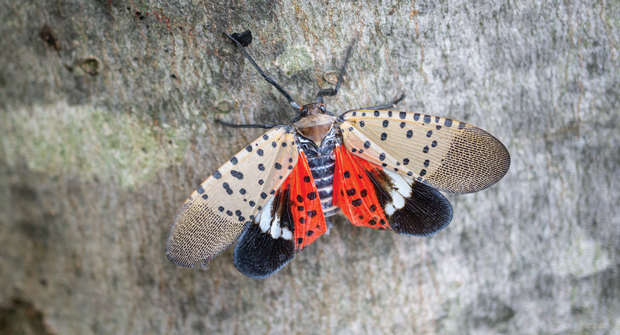
Aaron Hathaway
Technical services manager in turf and ornamentals
Nufarm
The spotted lanternfly (SLF) is a fast-moving insect pest, but it fortunately isn’t as devastating to its hosts as some other pests like emerald ash borer. It was first found in the U.S. in 2014 in Berks County, Pa., and made its way to New Jersey, New York, Maryland, Virginia, Ohio and seen in Michigan. SLF is more of a nuisance pest to trees but can devastate crops like hops, grapes, and others. It has many hosts on which they feed by piercing through plants and sucking the sugar-rich sap. They leave a wake of secreted honeydew, which attracts bees, wasps and other insects and promotes the growth of sooty mold, which can cover plants, patios, cars and anything else underneath heavily infested hosts.

Matt Wilkinson
Proprietary products manager
Albaugh Specialty Products
Doveweed is a weed primarily found near the Florida coast but has been emerging further north and more inland. This annual is often mistaken for Virginia buttonweed and can be difficult to kill. Split applications in February or March and again in April or May can help alleviate the potential of preemergent misses. Atrazine, S-metolachlor, dimethenamid, and indaziflam provide the best activity for preemergent options. Early identification for postemergent applications is essential as young doveweed plants can be difficult to differentiate among desirable warm-season grasses. Young leaves are most susceptible to chemical controls and postemergent combinations, including 2,4-D, dicamba, MCPA, sulfentrazone and metsulfuron tend to work best. However, multiple applications may be necessary.

Jared Hoyle, Ph.D.
Turf and ornamental territory manager
Corteva Agriscience
One emerging pest that LCOs should know about in 2024 is Japanese stiltgrass. As a summer annual that comes back year after year, populations and the seed bank can increase year-to-year if not controlled. LCOs must apply preemergent herbicides before germination. If LCOs apply preemergent herbicides too late, they will have to move to a post-application product. Dithiopyr, commonly utilized in weed control programs, can control postemergently at early growth stages as well as preemergence control thereafter.

Bobby Kerr, Ph.D.
Technical service manager
Quali-Pro
Bermudagrass mites (Eriophyes cynodoniensis) have become an increasing issue in the U.S. over the last several years. Mites are difficult to diagnose due to size (adults are 0.006 to 0.008 inches or 0.16 to 0.21 millimeters long). They are cigar or banana-shaped, translucent and have two legs. Development from egg to adult takes about two weeks and each female lays about 50 eggs. The combination of tiny size, quick life cycle and females producing a large number of eggs makes diagnosing and controlling bermudagrass mites challenging.


